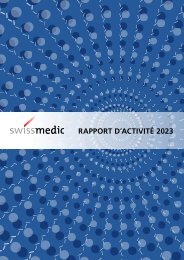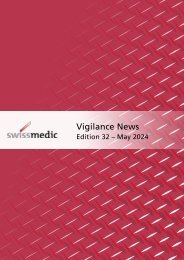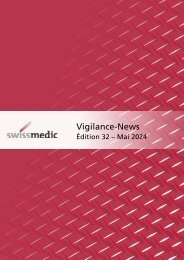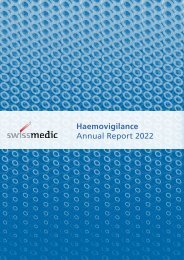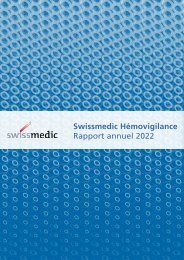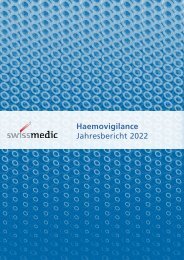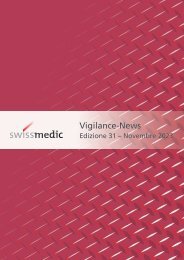Vigilance for veterinary medicinal products - Annual report 2022
Summary of adverse reactions reported in Switzerland in 2022
Summary of adverse reactions reported in Switzerland in 2022
You also want an ePaper? Increase the reach of your titles
YUMPU automatically turns print PDFs into web optimized ePapers that Google loves.
<strong>Vigilance</strong> <strong>for</strong> <strong>veterinary</strong><br />
<strong>medicinal</strong> <strong>products</strong><br />
<strong>Annual</strong> <strong>report</strong> <strong>2022</strong><br />
November 2023<br />
<strong>Vigilance</strong> der Tierarzneimittel | Jahresbericht 2021<br />
1
Credits<br />
Publisher<br />
Swissmedic, Swiss Agency <strong>for</strong> Therapeutic Products<br />
Veterinary Medicines Department<br />
Hallerstrasse 7<br />
3012 Bern<br />
Switzerland<br />
www.swissmedic.ch<br />
Editors/contacts<br />
Cedric Müntener, Veterinary Assessor<br />
Layout and typesetting<br />
lesgraphistes, Schmid Petra
<strong>Vigilance</strong> <strong>for</strong> <strong>veterinary</strong><br />
<strong>medicinal</strong> <strong>products</strong><br />
<strong>Annual</strong> <strong>report</strong> <strong>2022</strong><br />
Summary of adverse reactions <strong>report</strong>ed<br />
in Switzerland in <strong>2022</strong>
Contents<br />
1 A summary of the main points 4<br />
2 International comparison 5<br />
3 Distribution of the <strong>report</strong>s 6<br />
3.1 Distribution of the <strong>report</strong>s 6<br />
by source<br />
3.2 Distribution of the <strong>report</strong>s 7<br />
by ATCvet code<br />
3.3 Distribution of the <strong>report</strong>s 9<br />
by causality<br />
4 Reports from Tox Info Suisse 9<br />
4.1 Adverse reactions to <strong>veterinary</strong> 9<br />
<strong>medicinal</strong> <strong>products</strong> in animals<br />
4.2 Human exposure to <strong>veterinary</strong> 10<br />
<strong>medicinal</strong> <strong>products</strong><br />
5 Signals 12<br />
5.1 Signals in <strong>2022</strong> 12<br />
6 Conclusion 13
1 A summary of the main points<br />
• 422 <strong>report</strong>s, increase compared with 2021: 23%<br />
• Most frequently affected species: 254 dogs, 104 cats, 31 cattle<br />
• Most frequent <strong>medicinal</strong> product types: antiparasitics (141),<br />
hormone <strong>products</strong> (103), <strong>products</strong> to modulate the nervous system (76),<br />
antiinfectives (21)<br />
• 139 cases of suspected lack of efficacy, largely <strong>for</strong> antiparasitics and hormone<br />
<strong>products</strong><br />
• 47 cases passed on by Tox Info Suisse<br />
• 30 cases of accidental ingestion of flavoured tablets by dogs/cats<br />
• 104 cases of human exposure to <strong>veterinary</strong> <strong>medicinal</strong> <strong>products</strong><br />
• 6 signal procedures initiated<br />
<strong>Vigilance</strong> <strong>for</strong> <strong>veterinary</strong> <strong>medicinal</strong> <strong>products</strong> | <strong>Annual</strong> <strong>report</strong> <strong>2022</strong><br />
4
450<br />
400<br />
49<br />
350<br />
300<br />
39<br />
44<br />
50<br />
33<br />
250<br />
25<br />
45<br />
59<br />
35<br />
200<br />
53<br />
150<br />
50<br />
100<br />
50<br />
11<br />
18<br />
23<br />
32<br />
42<br />
30<br />
48<br />
39<br />
55<br />
0<br />
47<br />
44<br />
62<br />
86<br />
69<br />
76<br />
86<br />
121<br />
112<br />
147<br />
197<br />
243<br />
247<br />
218<br />
247<br />
290<br />
327<br />
315<br />
310<br />
373<br />
2003 2004 2005 2006 2007 2008 2009 2010 2011 2012 2013 2014 2015 2016 2017 2018 2019 2020 2021 <strong>2022</strong><br />
Food producing animals<br />
Companion animals, humans<br />
2 International comparison<br />
• Switzerland: 422 <strong>report</strong>s (<strong>2022</strong>)<br />
• Germany: 4086 <strong>report</strong>s (<strong>2022</strong>)<br />
• United Kingdom: 6139 <strong>report</strong>s (2020)<br />
• France: 4420 <strong>report</strong>s (2021)<br />
<strong>Vigilance</strong> <strong>for</strong> <strong>veterinary</strong> <strong>medicinal</strong> <strong>products</strong> | <strong>Annual</strong> <strong>report</strong> <strong>2022</strong><br />
5
3 Distribution of the <strong>report</strong>s<br />
3.1 Distribution of the <strong>report</strong>s by source<br />
Tox Info Suisse 47,<br />
11%<br />
Owners 1,<br />
0%<br />
Other 6,<br />
2%<br />
Professionals 47,<br />
11%<br />
Industry 321,<br />
76%<br />
Others: <strong>veterinary</strong> offices, official veterinarians<br />
The majority of the <strong>report</strong>s were submitted by the marketing authorisation holders. These<br />
do not refer to cases from clinical trials, but rather to cases <strong>report</strong>ed to marketing authorisation<br />
holders by practising veterinarians. This pattern has been observed <strong>for</strong> years both<br />
in Switzerland and various European countries.<br />
<strong>Vigilance</strong> <strong>for</strong> <strong>veterinary</strong> <strong>medicinal</strong> <strong>products</strong> | <strong>Annual</strong> <strong>report</strong> <strong>2022</strong><br />
6
3.2 Distribution of the <strong>report</strong>s by ATCvet code<br />
Number of <strong>report</strong>s and % of the respective total<br />
Medicine category by ATCvet code All species Dog Cat Livestock<br />
QA: Alimentary tract and metabolism 8 1.9% 5 2.0% 1 1.0% 2 4.8%<br />
QB: Blood and blood-<strong>for</strong>ming organs 1 0.2% 0 0.0% 0 0.0% 1 2.4%<br />
QC: Cardiovascular system 13 3.1% 10 3.9% 3 2.9% 0 0.0%<br />
QD: Dermatologicals 4 0.9% 3 1.2% 1 1.0% 0 0.0%<br />
QG:<br />
QH:<br />
Genitourinary system,<br />
sex hormones<br />
Hormonal preparations<br />
(excl. sex hormones and insulins)<br />
6 1.4% 3 1.2% 0 0.0% 3 7.1%<br />
103 24.4% 86 33.9% 10 9.6% 3 7.1%<br />
QJ: Anti-infectives 21 5.0% 2 0.8% 2 1.9% 16 38.1%<br />
QL:<br />
Antineoplastic and immunomodulating<br />
agents<br />
2 0.5% 1 0.4% 1 1.0% 0 0.0%<br />
QM: Musculoskeletal system 21 5.0% 9 3.5% 9 8.7% 3 7.1%<br />
QN: Nervous system 76 18.0% 42 16.5% 25 24.0% 7 16.7%<br />
QP: Antiparasitics 141 33.4% 80 31.5% 46 44.2% 5 11.9%<br />
QR: Respiratory system 1 0.2% 0 0.0% 0 0.0% 1 2.4%<br />
QS: Sensory organs 10 2.4% 9 3.5% 1 1.0% 0 0.0%<br />
QV: Miscellaneous 1 0.2% 0 0.0% 1 1.0% 0 0.0%<br />
«QZ» Reconverted <strong>veterinary</strong><br />
<strong>medicinal</strong> <strong>products</strong><br />
14 3.3% 4 1.6% 4 3.8% 1 2.4%<br />
422 100.0% 254 100.0% 104 100.0% 42 100.0%<br />
The distribution across the affected animal species (Table) has remained almost unchanged<br />
in recent years. The largest group (84% of all <strong>report</strong>s) is made up of companion<br />
animals (dogs, cats). They are followed in descending order by cattle with 31 <strong>report</strong>s,<br />
horses with 11 <strong>report</strong>s, and adverse reactions in users, which account <strong>for</strong> 5 <strong>report</strong>s.<br />
Fewer than five <strong>report</strong>s were received throughout the year <strong>for</strong> all other animal species.<br />
<strong>Vigilance</strong> <strong>for</strong> <strong>veterinary</strong> <strong>medicinal</strong> <strong>products</strong> | <strong>Annual</strong> <strong>report</strong> <strong>2022</strong><br />
7
Three cases of adverse reactions in persons using the <strong>products</strong> involved contact with the<br />
solution of a spot-on antiparasitic product. This <strong>veterinary</strong> <strong>medicinal</strong> product is a solution<br />
in a pipette that leaves a «sticky feeling» on the fingers upon contact with the skin due<br />
to its <strong>for</strong>mulation. Wearing gloves is expressly advised in the product's In<strong>for</strong>mation <strong>for</strong><br />
healthcare professionals and package leaflet due to the risk of (potentially serious) reactions<br />
in users.<br />
The high number of <strong>report</strong>s in the group of hormone <strong>products</strong> can be explained by a<br />
large number of <strong>report</strong>ed cases regarding a suspected lack of efficacy of an implant inducing<br />
temporary infertility in male dogs (68 <strong>report</strong>s). Suspected lack of efficacy can be<br />
confirmed by measuring testosterone levels: in 21 cases the lack of efficacy was proven,<br />
while in 33 cases it was refuted. No in<strong>for</strong>mation regarding testosterone levels was<br />
available <strong>for</strong> the remaining cases. In the case of antiparasitics, too, 48 out of a total of<br />
141 <strong>report</strong>s were submitted due to a suspected lack of efficacy, primarily against ticks.<br />
Regarding <strong>products</strong> to modulate the nervous system, 43 <strong>report</strong>s related to two new authorisations<br />
of monoclonal antibodies to control pain associated with osteoarthritis in<br />
dogs and cats dating from 2020. The largest number of <strong>report</strong>s is generally expected<br />
within the first two to five years following the authorisation of new active substances.<br />
Notable cases<br />
• Increased drinking (polydipsia) and more frequent urination (polyuria) in<br />
dogs following the use of bedinvetmab (a monoclonal antibody used to<br />
control pain associated with osteoarthritis). Modification of the «Side<br />
effects» section in the In<strong>for</strong>mation <strong>for</strong> healthcare professionals.<br />
• Use of a deslorelin implant in female dogs, accumulation of pus in the<br />
uterus (pyometra). Off-label use; in <strong>2022</strong> the <strong>veterinary</strong> <strong>medicinal</strong> product<br />
was authorised only <strong>for</strong> inducing temporary infertility in male dogs. No<br />
modification of the In<strong>for</strong>mation <strong>for</strong> healthcare professionals due to the<br />
off-label use.<br />
• In the case of one dog, licking an oestrogen-containing gel (a human<br />
<strong>medicinal</strong> product) led to alterations in its coat and enlargement of its<br />
mammary chain (effect of oestrogen).<br />
<strong>Vigilance</strong> <strong>for</strong> <strong>veterinary</strong> <strong>medicinal</strong> <strong>products</strong> | <strong>Annual</strong> <strong>report</strong> <strong>2022</strong><br />
8
3.3 Distribution of the <strong>report</strong>s by causality<br />
52; 12%<br />
65; 15%<br />
87; 21%<br />
88; 21%<br />
130; 31%<br />
A: Probable<br />
B: Possible<br />
O: Too little in<strong>for</strong>mation<br />
O1: Inconclusive<br />
N: No causality<br />
4 Reports from Tox Info Suisse<br />
4.1 Adverse reactions to <strong>veterinary</strong> <strong>medicinal</strong> <strong>products</strong><br />
in animals<br />
Overall, 47 cases satisfied the minimum criteria <strong>for</strong> <strong>report</strong>s (unambiguous identification<br />
of the patient, <strong>veterinary</strong> <strong>medicinal</strong> product and reaction) and were passed on to Swissmedic<br />
by Tox Info Suisse as part of a contractual agreement. 30 cases involved the accidental<br />
ingestion of <strong>veterinary</strong> <strong>medicinal</strong> <strong>products</strong> by animals, frequently in the <strong>for</strong>m of<br />
flavoured tablets. These primarily involved <strong>veterinary</strong> <strong>medicinal</strong> <strong>products</strong> <strong>for</strong> administration<br />
over a prolonged period such as anti-inflammatory drugs, <strong>products</strong> <strong>for</strong> the treatment<br />
of hypo- or hyperthyroidism, and antiparasitics. Although overdoses can be substantial<br />
(e.g. a 25-fold overdose of the anti-inflammatory active ingredient carprofen), they are<br />
often without consequence. In one case, a dog ingested 6 antibiotic tablets and 5 antiinflammatory<br />
tablets as well as around 130g of milk chocolate (chocolate can be toxic to<br />
dogs depending on its theobromine content).<br />
<strong>Vigilance</strong> <strong>for</strong> <strong>veterinary</strong> <strong>medicinal</strong> <strong>products</strong> | <strong>Annual</strong> <strong>report</strong> <strong>2022</strong><br />
9
4.2 Human exposure to <strong>veterinary</strong> <strong>medicinal</strong> <strong>products</strong><br />
8%<br />
1%<br />
30%<br />
36%<br />
25%<br />
Ingestion by child<br />
Accidental contact<br />
Mix-up<br />
Accidental injection<br />
Miscellaneous<br />
104 cases were recorded: as in previous years, mix-ups, accidental contact with <strong>veterinary</strong><br />
<strong>medicinal</strong> <strong>products</strong>, and ingestion of <strong>veterinary</strong> <strong>medicinal</strong> <strong>products</strong> by children each made<br />
up a third of cases. In addition, there were 9 cases of accidental self-injection. These cases<br />
cover a very broad spectrum of <strong>veterinary</strong> <strong>medicinal</strong> <strong>products</strong>, with those <strong>for</strong> long-term<br />
treatments – such as anti-inflammatories, <strong>veterinary</strong> <strong>medicinal</strong> <strong>products</strong> to treat hypo- or<br />
hyperthyroidism, and antiparasitics – being <strong>report</strong>ed more frequently. In most cases there<br />
were no symptoms, and the calls to Tox Info Suisse were primarily made as a precautionary<br />
measure.<br />
<strong>Vigilance</strong> <strong>for</strong> <strong>veterinary</strong> <strong>medicinal</strong> <strong>products</strong> | <strong>Annual</strong> <strong>report</strong> <strong>2022</strong><br />
10
4%<br />
2%<br />
8%<br />
26%<br />
59%<br />
1%<br />
Spot-On<br />
Solution<br />
Spray<br />
Tablet<br />
Paste, powder<br />
Other<br />
The classification of exposures by dosage <strong>for</strong>m shows that tablets, solutions and spot-on<br />
pipettes were most frequently involved. This largely refers to <strong>veterinary</strong> <strong>medicinal</strong> <strong>products</strong><br />
that are administered by the animal owners themselves, e.g. antiparasitics and anti-inflammatories.<br />
Exposures to solutions <strong>for</strong> injection tended to occur in a <strong>veterinary</strong><br />
practice or during administration by a veterinarian.<br />
<strong>Vigilance</strong> <strong>for</strong> <strong>veterinary</strong> <strong>medicinal</strong> <strong>products</strong> | <strong>Annual</strong> <strong>report</strong> <strong>2022</strong><br />
11
5 Signals<br />
5.1 Signals in <strong>2022</strong><br />
• Toxic effects of flunixin in carrion-eating birds: modification of the «Special<br />
warnings <strong>for</strong> each target species» and «Environmental compatibility» sections<br />
in the In<strong>for</strong>mation <strong>for</strong> healthcare professionals.<br />
• Black spots in cheese following the use of bismuth subnitrate-based teat sealants:<br />
modification of the «Special warnings <strong>for</strong> use», «Amounts to be administered<br />
and administration route» and «withdrawal times» sections in the In<strong>for</strong>mation<br />
<strong>for</strong> healthcare professionals<br />
• Use of isoflurane <strong>for</strong> the castration of piglets, risks <strong>for</strong> users and the environment:<br />
modification of the «Special warnings <strong>for</strong> each target species», «Special warnings<br />
<strong>for</strong> use», «Amounts to be administered and administration route» and «Environmental<br />
compatibility» sections in the In<strong>for</strong>mation <strong>for</strong> healthcare professionals<br />
• Paradoxical excitation following the administration of detomidine in horses:<br />
modification of the «Side effects» section in the In<strong>for</strong>mation <strong>for</strong> healthcare<br />
professionals<br />
• Local reactions following the use of deltamethrin 'pour-on' in cattle: modification of<br />
the «Side effects» section in the In<strong>for</strong>mation <strong>for</strong> healthcare professionals<br />
• Pulmonary oedema following the use of xylazine in calves: modification of the<br />
«Side effects» section in the In<strong>for</strong>mation <strong>for</strong> healthcare professionals<br />
<strong>Vigilance</strong> <strong>for</strong> <strong>veterinary</strong> <strong>medicinal</strong> <strong>products</strong> | <strong>Annual</strong> <strong>report</strong> <strong>2022</strong><br />
12
6 Conclusion<br />
The number of <strong>report</strong>s in <strong>2022</strong> showed a marked increase compared with 2021, which<br />
can be explained by the natural fluctuations of a spontaneous <strong>report</strong>ing system. It cannot<br />
be ascribed to any specific circumstances. Pharmacovigilance <strong>for</strong> <strong>veterinary</strong> <strong>medicinal</strong><br />
<strong>products</strong> remains an important tool <strong>for</strong> improving the safety of such <strong>products</strong> and <strong>for</strong><br />
reducing the risks to the individuals who use them. Every <strong>report</strong> submitted can make a<br />
crucial contribution to this end.<br />
Many <strong>report</strong>s of exposure passed on by Tox Info Suisse may appear anecdotal, but these<br />
should be viewed in the context of improving safety <strong>for</strong> the users and their families. They<br />
are important <strong>for</strong> an efficient pharmacovigilance system because they cover an additional<br />
spectrum of incidents with <strong>veterinary</strong> <strong>medicinal</strong> <strong>products</strong>. For example, they help identify<br />
possible risks to those in close contact with animal patients arising from incorrect uses or<br />
abuses of <strong>veterinary</strong> <strong>medicinal</strong> <strong>products</strong>.<br />
To conclude this <strong>report</strong>, we would like to thank all practising veterinarians and all other<br />
<strong>report</strong>ers who have taken the time to submit <strong>report</strong>s on observed adverse reactions<br />
during the course of the year.<br />
<strong>Vigilance</strong> <strong>for</strong> <strong>veterinary</strong> <strong>medicinal</strong> <strong>products</strong> | <strong>Annual</strong> <strong>report</strong> <strong>2022</strong><br />
13
Schweizerisches Heilmittelinstitut<br />
Institut suisse des produits thérapeutiques<br />
Istituto svizzero per gli agenti terapeutici<br />
Swiss Agency <strong>for</strong> Therapeutic Products<br />
Swissmedic, Swiss Agency <strong>for</strong> Therapeutic Products<br />
Veterinary Medicines Department<br />
Hallerstrasse 7<br />
3012 Bern<br />
Switzerland<br />
www.swissmedic.ch








